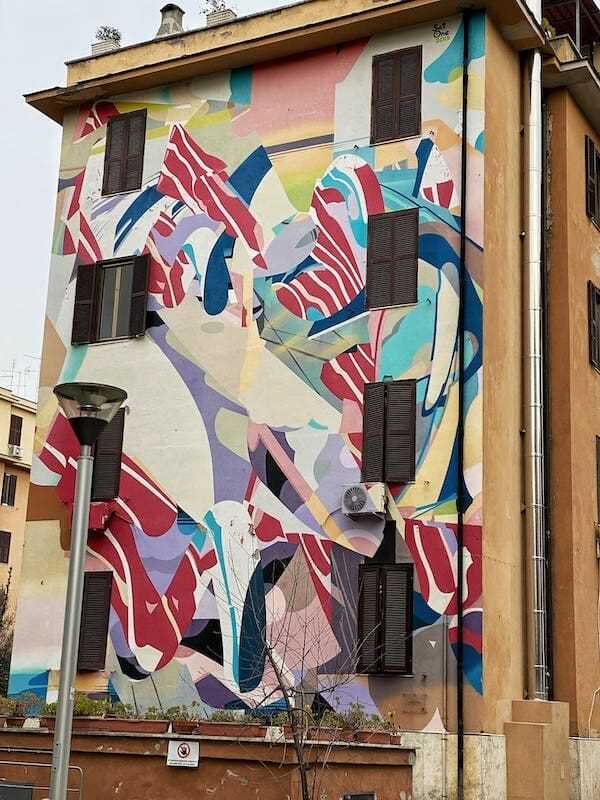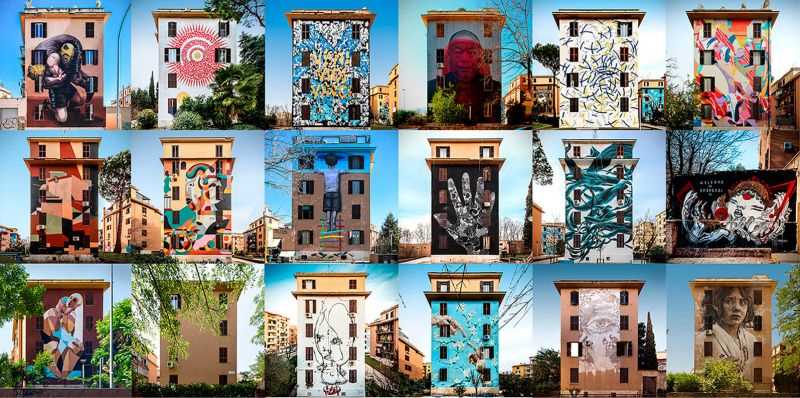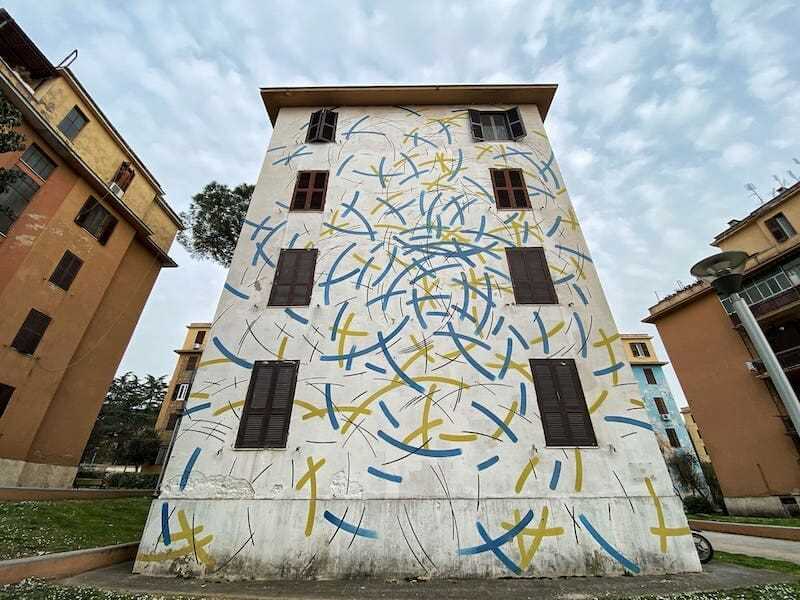
Tor Marancia, a neighborhood located on the outskirts of Rome, Italy, is home to a visually striking and thought-provoking street art project. What was once a neglected area with rundown buildings has been transformed into an open-air gallery, showcasing the talents of local and international artists. The walls of the neighborhood have become a canvas for urban creativity, with vibrant and colorful murals commanding attention at every turn.
This unique initiative began in 2015 when the local government invited artists to participate in an urban regeneration project. The aim was to revitalize the neighborhood and promote it as a destination for art lovers and tourists. The response from the artistic community was overwhelming, and soon, Tor Marancia became a hub for street art enthusiasts, photographers, and curious visitors.
The artworks in Tor Marancia reflect a wide range of themes and styles, offering a glimpse into the diverse and imaginative world of street art. From large-scale murals to intricate stencils, each piece tells a story and invites viewers to engage with the art and their surroundings. The artists not only explore social and political issues but also celebrate the vibrancy and cultural heritage of the neighborhood.
One of the most notable features of the street art in Tor Marancia is the use of vibrant colors and meticulous attention to detail. The artists have transformed dull and decaying walls into dynamic and energetic compositions that breathe life into the surroundings. Walking through Tor Marancia feels like navigating an open-air museum, where every corner holds a new surprise and discovery.

Tor Marancia is a neighborhood located in the southern part of Rome, Italy. It is known for its vibrant street art scene and has become a popular destination for art lovers and tourists alike. But before it became a hub for urban creativity, Tor Marancia has a rich history that dates back centuries.
Early History

The origins of Tor Marancia can be traced back to ancient Roman times. It was originally an agricultural area and was home to several farms and villas. The name “Tor Marancia” derives from the Latin word “torus,” which means land clearing, and “marancia,” which refers to the mulberry trees that once grew abundantly in the area.
In the Middle Ages, Tor Marancia became part of the Papal States and was ruled by various noble families. The area saw periods of prosperity and decline, but it remained predominantly rural until the late 19th century.
Urban Development and World War II

The urban development of Tor Marancia began in the early 20th century. Several residential buildings were constructed, and the neighborhood started to attract a mix of middle-class families and working-class individuals. However, this progress was interrupted by the outbreak of World War II.
During the war, Tor Marancia suffered heavy bombings, and many buildings were destroyed or damaged. The neighborhood was then occupied by German forces, further exacerbating the hardships faced by its residents. It wasn’t until the liberation of Rome in 1944 that Tor Marancia began to recover.
Post-War Rebirth and Street Art Movement

After the war, Tor Marancia experienced a period of rebirth and reconstruction. The damaged buildings were repaired, and the neighborhood slowly regained its vitality. However, it wasn’t until the 2010s that Tor Marancia truly caught the attention of the art world.
In 2015, the “Street Art Tor Marancia” project was launched, inviting international street artists to create large-scale murals on the walls of the neighborhood. The project aimed to transform Tor Marancia into an open-air art gallery and promote cultural exchange. Today, the neighborhood boasts an impressive collection of street art that attracts visitors from all over the world.
| Year | Event |
|---|---|
| 20th century | Urban development of Tor Marancia |
| 1944 | Liberation of Rome |
| 2015 | “Street Art Tor Marancia” project launched |
The Artists of Tor Marancia

Tor Marancia is home to a vibrant community of talented street artists who have transformed the neighborhood into an open-air gallery of urban creativity.
Another prominent artist in Tor Marancia is Alice Pasquini, whose murals can be recognized by their intricate details and emotive figures. Pasquini’s work often tells stories of human connection and empowerment, using her art to explore themes of love, hope, and resilience.
Collaborative Works

In addition to individual artists, Tor Marancia is also known for its collaborative mural projects. These projects bring together multiple artists to create large-scale murals that cover entire buildings. One such project is the Prima Porta Mural Project, which has transformed a group of buildings in Tor Marancia into a cohesive artwork depicting scenes from ancient Roman history.
Exploring Tor Marancia’s Art
Visitors to Tor Marancia can immerse themselves in the neighborhood’s street art by taking a self-guided tour. Maps and guides are available to help navigate the area and learn more about the artists and their work. The streets of Tor Marancia offer a feast for the eyes, with each corner revealing a new piece of art that adds to the vibrant tapestry of creativity in the neighborhood.
Whether you’re an art enthusiast or simply curious about urban culture, a visit to Tor Marancia is sure to inspire and captivate. The artists of this neighborhood have created a unique and dynamic artistic landscape that showcases the power of street art to transform and revitalize communities.
Themes and Styles
The street art in Tor Marancia showcases a wide range of themes and styles, reflecting the diverse creativity of the artists. From colorful abstract designs to intricate stencil work, there is something for everyone to appreciate.
One common theme found in the artwork is social and political commentary. Many pieces address issues such as inequality, poverty, and environmental concerns. The artists use their work as a form of expression and a way to bring attention to important social issues.
Another common theme is pop culture and popular references. Some artists incorporate well-known characters and symbols from movies, music, and literature into their pieces. These references add a playful and familiar element to the artwork, making it relatable for viewers.
The styles of the artwork also vary greatly. Some pieces are bold and expressive, using vibrant colors and intricate patterns to catch the eye. Others are more subtle and nuanced, using muted tones and delicate details to create a sense of depth and texture.
Stencil work is a popular technique used by many of the artists in Tor Marancia. This style involves cutting out a design on a stencil and then applying paint or ink through the stencil onto a surface. This technique allows for precise and intricate detailing, and many artists have mastered it to create stunning and visually striking pieces.
In addition to stencils, artists also use a variety of other techniques such as freehand painting, wheatpasting, and installations. These different styles and techniques contribute to the diversity and richness of the street art scene in Tor Marancia.
Overall, the themes and styles found in the street art of Tor Marancia create a vibrant and dynamic urban gallery. Whether you’re a fan of social commentary, pop culture references, bold colors, or intricate designs, there is something for everyone to enjoy and appreciate in this unique art destination.
Community Engagement and Interaction

One way street art engages the community is by providing a platform for self-expression. Local artists have used the walls of the neighborhood to express their thoughts, feelings, and messages. The artwork often reflects the history, culture, and identity of the community, creating a sense of pride and connection among residents.
In addition to self-expression, street art also encourages interaction among community members. People from all walks of life come together to appreciate and discuss the artwork, fostering a sense of unity and camaraderie. The murals become a focal point for social gatherings, where neighbors can gather, admire the art, and engage in conversations with one another.
Furthermore, street art has the power to transform neglected spaces into vibrant gathering places. The once-empty walls and vacant lots have become hubs of activity and creativity, attracting not only residents but also visitors from other areas. This newfound vibrancy helps to revitalize the neighborhood, improve the quality of life, and boost local businesses.
Overall, the street art in Tor Marancia serves as a catalyst for community engagement and interaction. It sparks conversations, fosters a sense of belonging, and transforms the neighborhood into a vibrant and thriving community. Through this unique form of artistic expression, the residents of Tor Marancia have found a way to connect with one another and create a shared identity.
Preservation and Conservation

In addition to being a vibrant display of urban creativity, the street art in Tor Marancia also serves as a reminder of the importance of preservation and conservation. As an art form that is often created on public walls and buildings, street art faces the challenge of preservation in the face of weathering, vandalism, and redevelopment.
Preserving street art requires a delicate balance between allowing artists to express their creativity and ensuring that the artworks are protected for future generations to enjoy. Some cities have implemented policies and initiatives to protect and conserve street art, recognizing its cultural and artistic value.
Conservation efforts for street art can involve various techniques and approaches. The use of protective coatings can help prevent damage from weathering and graffiti. Regular cleaning and maintenance can also help preserve the artworks. Additionally, some street art murals have been moved to indoor locations or covered with transparent panels to safeguard them from the elements.
While street art is often associated with temporary and ephemeral nature, its preservation and conservation are crucial to the artistic and cultural heritage of a city. By recognizing its value and implementing measures to protect it, we can ensure that street art continues to enrich our urban landscapes and inspire future generations.
The Impact of Street Art on Tor Marancia

Tor Marancia, a neighborhood in Rome, has experienced a tremendous transformation through the introduction of street art. What was once a place with crumbling buildings and a lack of aesthetic appeal, has now become a vibrant and lively community, thanks to the impact of street art.
The street art in Tor Marancia has not only brought color and beauty to the neighborhood, but it has also revitalized the community spirit. Prior to the introduction of street art, Tor Marancia was a neglected area, with residents feeling disconnected from each other and their surroundings. However, with the creation of stunning murals and artwork on the walls of buildings, the residents now have a sense of pride in their community.
“Street art has given our neighborhood a new identity,” says one resident. “It has brought people together and created a sense of belonging.”

In addition to fostering community spirit, street art has also had a positive economic impact on Tor Marancia. The increase in tourism and interest in the neighborhood has led to the opening of small businesses, such as cafes and art galleries. This has not only provided employment opportunities for the locals, but it has also boosted the local economy.
The impact of street art on Tor Marancia extends beyond the neighborhood itself. The colorful murals and vibrant artwork have attracted attention from around the city and even internationally. Tourists and art enthusiasts flock to Tor Marancia to admire the creativity and talent on display, further enhancing the reputation of the neighborhood.
“Street art has put Tor Marancia on the map and made it a destination for art lovers,” says a local curator.

Overall, the impact of street art on Tor Marancia has been undeniable. From improving the aesthetics of the neighborhood to fostering a sense of community and boosting the local economy, street art has transformed Tor Marancia into a true hub of urban creativity.

I am a mural enthusiast and a fervent admirer of street art. Rather than creating murals myself, I am passionate about collecting them. My love for street art knows no bounds. I am dedicated to curating and cherishing these artworks that grace the streets. My collection stands as a testament to my profound appreciation for this form of artistic expression.
read about me



